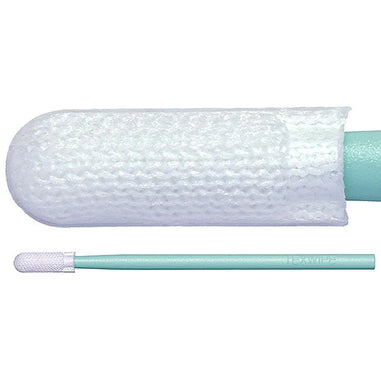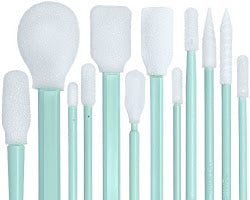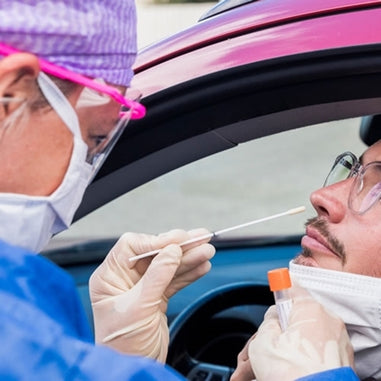- No products in the cart.
Lab Swabs – Tools and Tips for Almost Any Task
The first commercial cotton swab was invented in 1923 by Leo Gerstenzang, who modeled it after an apparatus his wife fashioned of toothpicks and cotton to clean their baby’s ears.1 The original design of the device was simple, similar in appearance to the prepackaged, wooden sampling swabs that have long been staples in doctors’ offices. The humble swab is no longer unsophisticated and is now an indispensable instrument for many ground-breaking industries.
Modern day lab swabs are made of a variety of high-tech materials for a plethora of purposes beyond just cleaning and contamination removal.
- Medical-grade swabs are used to take microbial cultures.
- Sterile swabs sample surfaces for cleanroom control.
- Static control swabs are essential for medical device manufacturers.
- Fluid application swabs deliver coating or lubricant to mini-mechanical assemblies.

Lab Pro’s Ultimate Swab Guide can help you select the right swab for your medical device manufacturing, fiber optics, medical, cleanroom, PCB manufacturing, general lab, or electronics manufacturing venture. This introduction will give you an overview of different types of lab swabs and applications. Visit our web site for selection and specifics on cotton, foam, cleanroom and polyester swabs.
Tip Specific
Both the shape and material of a swab tip influence its efficacy. The tip of a typical swab is made of cotton, which is low cost and absorptive, but can also shed. An absorptive open-celled polyurethane tip won’t leave behind fibers but can degrade when exposed to certain solvents. For the toughest jobs, like scrubbing dried flux residue around a PCB component, a closed cell foam or knitted polyester tip will provide chemical resistance to solvents without tearing or fraying. Sterile swabs are required for biological sampling.
Stem Significance
The stem, or handle of a lab swab, can be made of wood, paper, plastic, or even metal. Wooden handles are cost effective and biodegradable but can break under stress or can introduce dust to an environment. Longer handles may be more useful for hard-to-reach spots and sampling, while shorter handles are designed for detailed work and cleaning. Sturdy stems are needed for scrubbing, while sampling swabs may need easily breakable handles.
Plastic handles can be made of different types of polymers such as nylon, ABS, or polystyrene. They can be tailored to end-use, whether strength, stiffness, chemical resistance, grip, or flexibility is needed. Swab tips can also be heat-melded to the handle without using adhesives to minimize contamination.
Cotton Swabs
Cotton is comprised of 99% cellulose, a macromolecule with three water absorptive hydroxyl (-OH) groups on each repeating unit. Most cotton swabs have environmentally responsible wooden or paper handles. Some poly foam tips have cotton cores for extra absorbance.
- Most common swab
- Economical, soft, absorbent
- Good resistance to alkalis and normal cleaning solvents
- Used in for cell collection and DNA testing in medical and law enforcement
- Can leave behind fibers
- Fibers can snag
- Also available with tapered, microtip, no glue, or low linting tips
Polyurethane Foam Swabs
Polyurethanes are polymers comprised of alternating copolymers that can be tailored for strength, flexibility, or toughness.
- Economical, strong
- Tolerant to alcohol
- Intolerant to harsh solvents like toluene and ketones
- Does not leave fibers behind
- Tougher and cleaner than cotton
- Available in a variety of tip shapes and sizes for various end-use applications
Open cell foam swabs are super absorbent. Reticulated foam is very porous and low density for maximum absorbency. Flexible tips provide versatility and a softer touc.
- The most cost-effective swabs for general-purpose applications
- 100 ppi reticulated medical-grade foam provides excellent particle entrapment
- The open-cell structure gives the best solvent holding capacity of any style of swab
- Free of adhesives or binders that could contaminate your process
- Fiberless construction does not generate particles
Fine foam swabs have a tighter cell structure for excellent particle entrapment characteristics. They are strong, durable, and trap contaminants during cleaning.
- Superior durability
- Provides gentle, nonabrasive cleaning of sensitive surfaces
- 100 ppi foam head
- Traps surface particles while cleaning
- High solvent capacity; holds solvent well
- Fiberless construction does not generate loose fibers or particles
- No adhesives or binders are used in the construction
- Economical for high quantity applications
Knitted (Woven) Polyester Swabs
Polyesters are thermoplastic polymers made from dialcohols and diacids. Polyester swabs are tough with good chemical, heat, and abrasion resistance. Pillow-top swabs are ultra-absorbent.
- High precision
- Durable for scrubbing
- Super for sampling due to ability to absorb and release liquids
- Lowest non-volatile residue for clean environments
- Available in a variety of styles, including welded tips
ESD (Electro-static Dissipative)
ESD swabs are engineered to eliminate damage from static electricity. Electrostatic-dissipative handle swabs will dissipate 99% of a 5,000-volt charge in less than 2.0 seconds. Choose between our Class 10 (ISO Class 4) laundered polyester or 100 pore-per-inch ultraclean polyurethane foam. ESD handles are often blue for easy identification.
- Excellent solvent resistance, even to acetone
- Surface resistivity of 10 EE10 ohms/sq.
- Low ionic, nonvolatile residue (NVR), and particulate contamination
- No humidity dependency
- No Amines, no silicones, no static dissipative coatings
- No Tribo-charge generated
Wrapped swabs can be made of cotton, foam, or polyester. These swabs have no sealed edges, to reduce the risk of scratching delicate substrates.
- Expensive because they are hand-made
- High areas squeegee surface and low areas collect soils
- Liquid wicks to fine tip for applying lubricants, adhesives, or solvents
- Generates fewer particles
- Specialty designs for fiber optics, cleaning high end disk drive components, etc.
Swab Selection for End-use Application
Selecting a suitable swab for your assignment involves matching the mechanical and chemical compatibility of the tip and handle with the solvent, substrate, surface, and task.
Surface Sampling Swabs
Inert, chemical resistant polyester has no plasticizers that will leach out and is almost impermeable to liquids or gases. These properties make polyester tips ideal for cleaning validation, a process in which a collection solvent is rubbed on a surfaced, extracted, and then analyzed for Total Organic Carbon (TOC) by FTIR, NMR, spectrographic, or chromatographic technique.
Cleanroom grade polyester knit swabs are made without glue and are low NVR. They absorb liquids efficiently and release extraction liquid easily for analysis. Stiff handles that can be notched provide clean breaks for sample submission. Smaller pack sizes reduce risk of contamination.
Lab Pro offers several types of FDA registered nylon microfiber sterile sampling swabs by Chemtronics that are ETO sterilized - free from human DNA, enzymes that degrade DNA and RNA, and polymerase chain reaction inhibitors.
General Cleaning
Cost can be a consideration for general cleaning. All of Lab Pro’s swabs meet quality standards for typical lab maintenance.
- Light soils: Polyurethane foam, polyester fiber, and cotton swabs are suitable for mild solvents like isopropyl alcohol and light hydrocarbons. Open-cell polyurethane foam swabs capture particles and liquid.
Precision Cleaning
Soil, substrate, and stem are considerations for exactitude cleanup.
- Absorbency: Reticulated foam with a cotton core ensures excellent absorbency while minimizing contamination.
- Scrubbing surfaces, and tough soils: Closed-cell foam withstands aggressive scrubbing of greases, waxes, fluxes, and adhesives and inhibits absorption.
- Harsh solvents, rough surfaces: Knitted polyester is resistant to ketones, halogenated solvents, esters, and aromatics and is strong enough to scrub off to remove flux residues and adhesives around PCB components.
- Fiber optics: Reticulated foam and polyester are popular materials for specialty fiber optics swabs. Polyester tips can be formulated to withstand Electro-Wash PX or CZ solvent cleaner. Handles are thin for easy reach.
Applying Fluids
The chemical compatibility of both swab tip and handle with the fluid to be applied are critical, as well as the shape, size, and geometry of the swab. Polyester swabs tolerate lubricants, adhesives, and coatings.
- Applying small drops: Small, pointed swabs, or arrow-head tips, are able to deposit small drops precisely.
- Applying fluid over a large area: Larger swabs with enhanced holding capacity cover a greater surface area.
- Pinpoint accuracy: Microtips are designed for precision applications needing pinpoint accuracy. The tapered porous polyvinylidene fluoride tip is effective as a stylus or pick for areas with tight tolerances. The tip is attached to the handle without the use of potentially contaminating adhesives or glues. These swabs are ideal for adhesive and lubricant application.
- Precision lubricant application: Wrapped foam or polyester swabs wick well because channels deliver a controlled amount of lubricant to mini mechanical assemblies or ball bearings.
Static Control
Tribocharging is the buildup of static electricity by rubbing two materials. An electrostatic field can be generated surface by a service technician as a swab is rubbed against a surface. Swabs with ESD safe hands drain the static charge field slowly to protect sensitive electronic devices and PCBs from high voltage ESD.
To work with ESD-safe swabs, the operator needs to complete the path from the swab to the ground through hands, ESD-safe gloves, and then a wrist grounding strap. The swab tip must be wetted to complete the circuit.
- Lab Pro’s ESD-safe swabs are made of polypropylene/dissipative plastic alloy are resistant to harsh solvents, even acetone.
That is our introduction to the swab selection process. Did you have a question that wasn’t addressed in the post or have a question about your application? If so, leave us a comment below and we’ll get back to you as soon as we can. In the meantime, have a look at our selection of cotton, foam, cleanroom and polyester swabs here.
Note: These products and chemicals are meant to be used for research, industrial work, cleaning or disinfecting and should always be stored out of the reach of young children or infants.
For over 40 years, Lab Pro Inc. has been committed to delivering the highest quality swabs, chemicals, ESD protection, laboratory and cleanroom PPE supplies to medical device and electronic manufacturing laboratories worldwide. To learn more, visit the biggest Lab Supply showroom in California, or contact us online or at 888-452-2776.
References
1: About: A Q-Tips® Cotton Swabs History, Unilever United States, 2007–2018












































